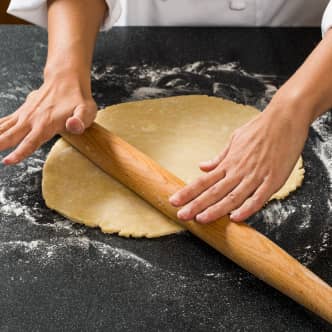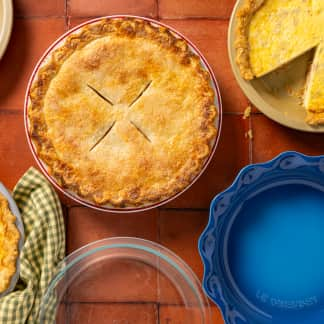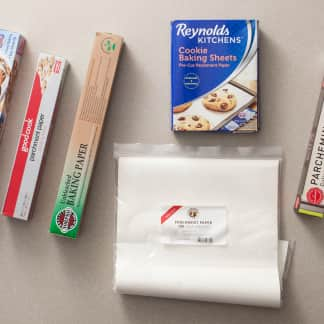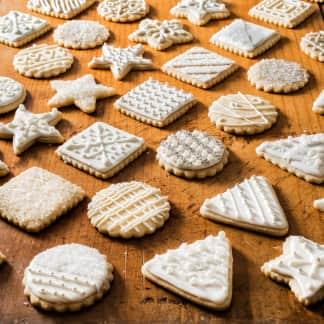The best rolling pins easily and efficiently roll out all kinds of doughs without sticking or ripping. We named two winners: a straight rolling pin, the JK Adams Plain Rolling Dowel Pin, and a tapered rolling pin from the same manufacturer, the JK Adams French Rolling Pin. Both are made from North American hardwood and have a slightly rough texture that holds a fine dusting of flour well, making them virtually nonstick. They’re also wide enough to roll out even large doughs and heavy enough to assist us without feeling cumbersome. A straight dowel has the benefit of more heft and is often used for larger jobs such as batches of croissants. Tapered pins are a bit lighter and thinner and thus offer finer control.

Rolling pins are necessary when making most pie dough and tart dough, as well as many cookies; biscuits; tortillas; and yeasted doughs such as croissants, pretzels, and bagels—basically all of the best foods. We tested rolling pins in three styles: handled pins, dowels, and tapered pins (also called French rolling pins). The rolling pins in our lineup were made from marble, plastic, stainless steel, and wood.


We use rolling pins to make some of our favorite desserts, including tarts and pies.
Rolling pins with handles are likely familiar to most home bakers. You hold the handles and push down and away while the pin rotates. Dowels and tapered pins work similarly to each other. Rather than grip them, you place your palms on the surface of the pins. As you apply pressure and move your arms back and forth, the pins glide over the dough. We rolled out dozens of pie doughs, pizza doughs, and cookie doughs and found several options that rolled over their competition.
The Big Debate: Dowel Rolling Pins versus Tapered Rolling Pins
We didn’t like rolling pins with handles. It’s easier to assess a dough’s thickness and how hard to press when using a dowel or tapered pin. Between a dowel and a tapered pin, each has its benefits and the choice is a personal one. Some bakers find dowels easier to use because the weight is distributed evenly across the barrel. They require less technique than a tapered pin, and their heft and length make them especially suited for large jobs such as croissants or slab pies. Tapered pins are lighter, thinner, and offer finer control. However, there’s a slight learning curve to using tapered pins. Their smaller size also makes them easier to store. Regardless of which style works for you, there are some important things to look for and to avoid when shopping.
What to Look For
- Wood Pins: Rolling pins made from wood were the most efficient as well as the easiest to use. First, wood’s slightly rough surface held a fine dusting of flour, making these pins virtually nonstick. Second, the textured wood gripped the dough well, causing the dough to be responsive to our movements.

- Moderate Weight: The rolling pins we tested weighed from about 8 ounces to more than 4 pounds, a dramatic range. Our favorites weighed from about 1 to 1½ pounds, making them heavy enough to assist us while rolling but not so heavy as to make them uncomfortable while using.
- Long Barrels: Most pie recipes call for a 12-inch circle of dough, while croissants or slab pie require rolling dough to larger dimensions. Rolling pins with shorter barrels left unwanted indents where their edges pressed into the dough. These pins also required more passes over the dough, which extended the rolling time. This can also overwork and heat up the dough, causing it to turn out tough, rather than light and flaky.
What to Avoid
- Marble, Plastic, or Stainless-Steel Pins: Bakers sometimes praise marble and stainless-steel rolling pins because they can be chilled before use, which can help keep the dough cool while rolling it out, a plus in a hot restaurant or bakery kitchen. But those materials have flaws. The marble model we tested weighed 4.5 pounds, which felt cumbersome and crushed the air bubbles out of proofed pizza dough. Stainless steel in particular is sensitive to warmth as well as to cold; when we didn’t pre-chill it, the pin warmed under our hands, which can warm up the dough as well and result in tough, dense pastries. Marble, stainless-steel, and plastic models were also too smooth to hold a dusting of flour and stuck to pie dough as a result.
- Too Light or Too Heavy: Pins that were too light required us to work harder to achieve the same results as when we rolled with a moderately weighted pin. Pins that were too heavy were cumbersome to use, and we had to put them down each time we rotated the dough, slowing down the process. Most importantly, the heaviest pins crushed the air bubbles out of pizza dough while rolling.
- Dramatically Tapered Rolling Pins: Although the tapered pins were roughly 20 inches long, each had different lengths of usable flat space, from 5.2 to 9.5 inches. It was easy to make unwanted indents while using the pins with the shortest amount of usable space, and we had to work a little harder to achieve an evenly flat dough.


Tapered rolling pins had different lengths of usable flat space. When using the rolling pin with only 5.2 inches of flat surface area (left), we created hills and valleys and struggled to produce even rounds of dough. It was easier to use tapered rolling pins with more flat space (right).
- Rolling Pins with Handles: It is more difficult to assess a dough’s thickness when using a handled pin than it is when using a dowel or tapered pin. It’s also more challenging to assess how hard we’re pressing. We struggled when rolling out cookie dough between two sheets of parchment. It’s possible for the handles to turn instead of the barrel of the pin, which means that the pin just skids along a dough rather than flattening it.

Other Considerations
- Removable Rings: One rolling pin had a 13.6-inch long barrel with sets of removable plastic rings that twisted onto each end of the pin. The rings came in four sizes: 1/16-, 1/6-, 1/4-, and 3/8-inch. They are meant to help novice bakers achieve even dough. We loved that we knew that we were rolling out the dough to precisely that thickness. However, the design created other problems. When we rested our hands on the barrel, they landed directly on top of the rings, which pressed uncomfortably into our palms. If we moved our hands further in, our arms felt uncomfortably squished in front of our bodies. Also, the rings made deep impressions in doughs wider than 13.5 inches. We think these removable rings are a helpful innovation for newer bakers, but the pin is simply too small to be versatile.
The Tests
- Roll pie dough to a 12-inch circle
- Roll pizza dough to a 15 by 11-inch rectangle
- Roll cookie dough between parchment paper to a 10 by 14-inch oval
- Have a novice baker roll pie dough to a 12-inch circle
How We Rated
- Performance: We considered which rolling pins successfully produced thin, even doughs without sticking, tearing, or creating undesirable marks or indents.
- Ease of Use: We evaluated how easy and comfortable the pins were to use.
- Cleaning: We rated the pins on how easy they were to clean by hand.






















